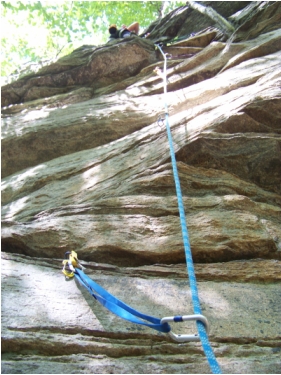The Alpine Draw
The best tool for managing rope drag is the alpine
draw. This is the only kind of quickdraw most trad climbers
bring on climbs, since it is more versatile than a sport draw and more
convenient than a sling over your shoulder. In the video below, Cristina describes how to rack an alpine draw. To extend a placement, simply clip one of the alpine draw's carabiners into the sewn runner attached to the cam or through the loop on the nut, and pull the other carabiner off two of the three loops of the alpine draw (see video if this sounds confusing: it's not). Clip your rope into this, and you have an extra two feet of play in the rope line. This will lower the height of your last clip, making a fall slightly longer, but usually reducing rope drag is well worth the fall potential. If you are in danger of hitting a ledge or decking out, you may not want to extend your clip. Only you can decide in each situation.
Places to consider extending your placement include:
Places to consider extending your placement include:
- Underneath overhangs, particularly in corner placements
- When the route turns sharply
- In deep dihedrals
- Where your lower carabiner falls on a sharp edge (to prevent breakage)

